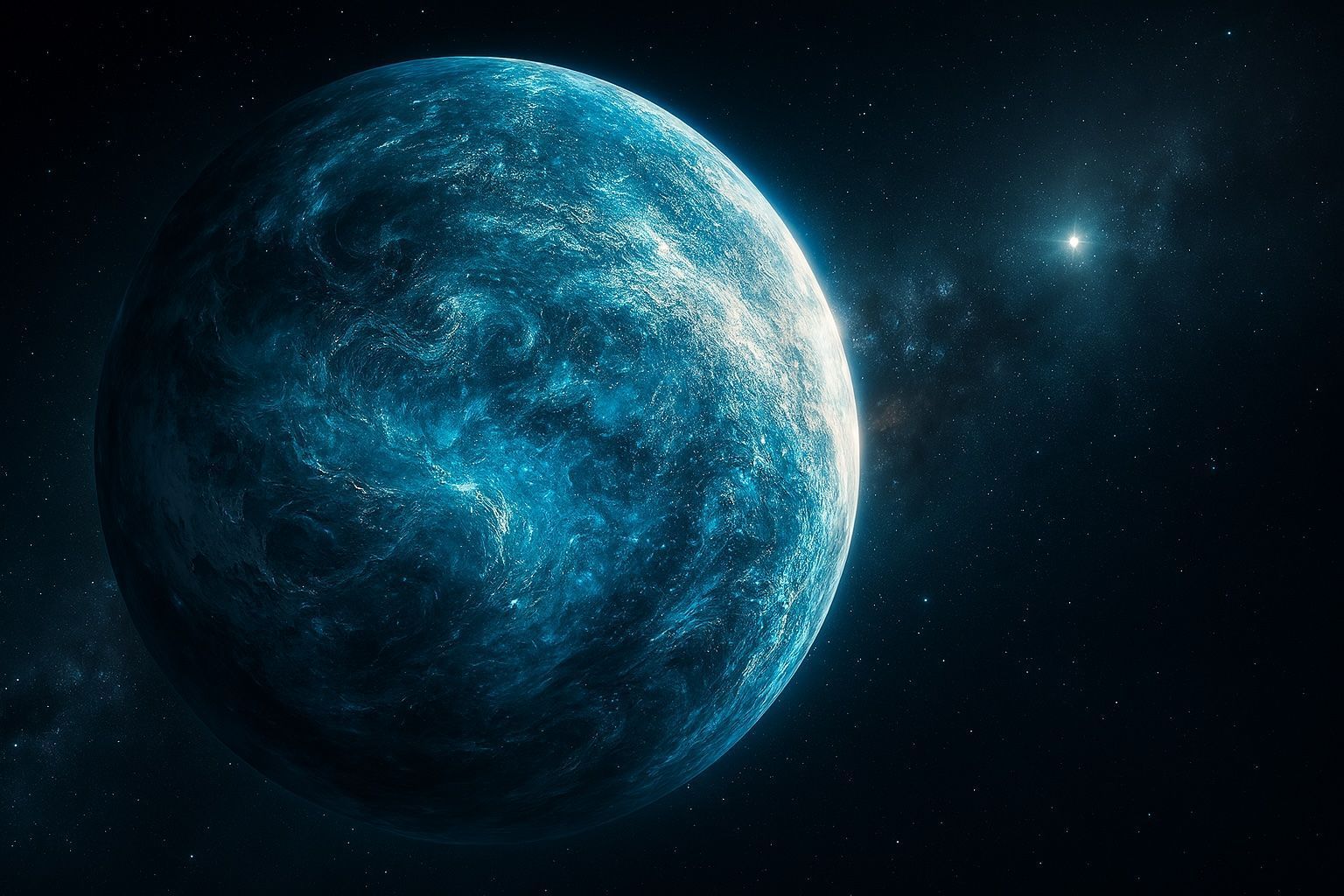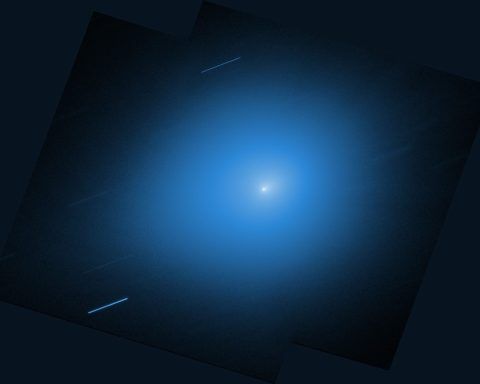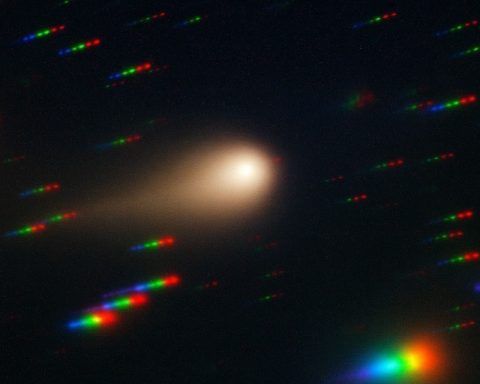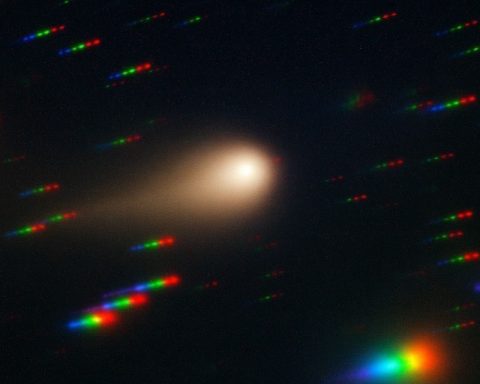- Ammonite is the informal name for the trans-Neptunian object 2023 KQ14, discovered by the FOSSIL survey with Subaru’s 8.2-meter telescope in early 2023.
- Follow-up observations in July 2024 with the Canada–France–Hawaii Telescope and archival data from 2005 extended its observational arc to 19 years.
- Ammonite is a sednoid, a distant trans-Neptunian object with a highly eccentric orbit (e ≈ 0.74) and a diameter estimated at 220–380 km.
- Its orbital direction is markedly different from the three previously known sednoids, breaking their apparent clustering.
- Backward and forward simulations show Ammonite has been on a stable solar orbit for at least 4.5 billion years, with a possible clustered alignment about 4.2 billion years ago.
- Based on brightness, Ammonite is roughly 220–380 km across and could be spherical if composed of rock and ice, though it is currently classified as a minor planet rather than a dwarf planet.
- Its discovery helps fill the “perihelion gap” around 50–75 AU, with a perihelion around about 66 AU.
- At its farthest, Ammonite may reach ~250 AU from the Sun, and a full orbit could take roughly 4,000 years.
- The orbit’s misalignment suggests Planet Nine, if real, would need a much farther orbit (likely beyond 500 AU) to avoid perturbing Ammonite.
- The Vera C. Rubin Observatory’s LSST is planned to begin full operations in 2025–26, with the goal of discovering thousands of distant objects and dozens of sednoid candidates.
A New Fossil World Beyond Pluto
Astronomers have announced the discovery of an extraordinary small world at the outermost fringe of our Solar System. Nicknamed “Ammonite,” this distant object – officially designated 2023 14 – was found beyond Pluto’s orbit and is being hailed as a potential “fossil” from the early Solar System [1]. The object lies so far from the Sun that it takes orbiting to extremes: its closest approach to the Sun is about 71 astronomical units (AU) away (1 AU is the Earth–Sun distance, ~93 million miles) [2]. At that distance, Neptune’s gravitational influence wanes, placing Ammonite in a rare class of distant bodies. Ammonite is not a full-fledged planet by formal definition, but rather a type of trans-Neptunian object known as a “sednoid,” a category so elusive that only three others have ever been observed [3]. In fact, the discovery was published in Nature Astronomy on July 14, 2025 [4] [5], and by the next day headlines were calling it a new world on the Solar System’s edge [6] for its significance.
Discovery by Subaru’s FOSSIL Hunt – Who Found Ammonite and How
The new object was detected by an international team of astronomers as part of the Formation of the Outer Solar System: An Icy Legacy (FOSSIL) survey project using Japan’s 8.2-meter Subaru Telescope on Maunakea, Hawaii [7] [8]. Subaru’s powerful Hyper Suprime-Cam digital camera enables extremely wide-field scans of the sky, perfect for catching faint, slow-moving objects in the far Solar System [9]. In early 2023, the FOSSIL team spotted a suspicious moving speck in images taken in March, May, and August 2023 on Subaru’s telescope [10]. This distant speck was later confirmed with follow-up observations in July 2024 on the Canada–France–Hawaii Telescope (CFHT) [11]. By searching old archival data from other observatories, astronomers realized the object had actually been unknowingly recorded as far back as 2005, giving them an observational arc of 19 years to refine its orbit [12].
The team behind Ammonite’s discovery spans multiple countries and institutes. Leading the project are Dr. Shiang-Yu Wang and Dr. Ying-Tung Chen of Academia Sinica’s Institute of Astronomy and Astrophysics (ASIAA) in Taiwan [13]. They collaborated with colleagues from the National Astronomical Observatory of Japan (NAOJ), Kindai University in Japan, National Central University in Taiwan, the National Research Council of Canada, the Korea Astronomy and Space Science Institute, Nanjing University in China, and others [14]. The object’s provisional designation 2023 KQ14 was assigned by the Minor Planet Center, but the discovery team informally nicknamed it “Ammonite.” In paleontology, ammonites are fossilized spiral-shelled creatures; here the name evokes a fossil of the Solar System. Indeed, Ammonite’s orbit appears to be a pristine relic from the Solar System’s infancy, preserved for billions of years with minimal disturbance [15].
Figure: The orbit of “Ammonite” (red) compared to the orbits of the three previously known sednoids (white). All have extremely elongated paths far beyond Neptune (cyan circle). Ammonite was found near its closest point (perihelion) ~71 AU from the Sun [16].
What Is a Sednoid? A Quick Astronomy Explainer
Sednoids – named after Sedna, the first such object discovered in 2003 – are a rare sub-class of distant trans-Neptunian objects (TNOs) on extraordinarily remote orbits. These bodies have highly eccentric (elongated) orbits with perihelion (closest solar distance) well beyond Neptune (30 AU) [17]. In practice, astronomers define “Sedna-like” objects as those with perihelia greater than ~60 AU and semi-major axes beyond ~200 AU [18]. Such orbits mean sednoids never come close enough to the big planets to be strongly perturbed by them, effectively “detaching” them from the rest of the planetary region [19] [20]. Sednoids are extremely difficult to find because at those distances they are faint and move very slowly across the sky. Until now, only three sednoids were known: 90377 Sedna (discovered 2003, perihelion ~76 AU), 2012 VP<sub>113</sub> (perihelion ~80 AU, nicknamed “Biden”), and 541132 Leleākūhonua (perihelion ~65 AU) [21] [22].
The existence of these remote objects has been a major puzzle in planetary science. Their orbits can’t be explained by interactions with the known giant planets alone [23]. Over the years, scientists have proposed various ideas for how sednoids got thrown onto such distant trajectories – for example, a passing star in the Sun’s birth cluster that gravitationally jostled the young Solar System, capture of rogue interstellar objects, or the intriguing possibility of an undiscovered massive planet (“Planet Nine”) lurking far out and shepherding these objects [24] [25]. The sednoids’ orbits appeared to exhibit a clustering in direction, which was one of the clues that led astronomers Konstantin Batygin and Mike Brown in 2016 to hypothesize a ninth planet several times Earth’s mass far beyond Neptune. However, with such a small sample of objects, it has been hard to be sure of any patterns [26]. This is why each new sednoid discovery is so significant: finding more of these fossils helps scientists piece together the Solar System’s early history and test competing theories [27] [28].
Scientific Significance – A Missing Puzzle Piece in the Outer Solar System
The discovery of Ammonite is making waves because it fills a longstanding gap in our knowledge of distant orbits. Astronomers had noted an apparent “perihelion gap” – a range of distances (roughly 50–75 AU) where no known TNOs had been found to come closest to the Sun [29]. Objects like Sedna and 2012 VP<sub>113</sub> stay well beyond 75 AU at perihelion, while many others (like routine Kuiper Belt objects) come in closer than 50 AU. Ammonite, with a perihelion of ~66 AU, lands right in the middle of this gap [30] [31]. Its discovery proves that this region was not truly empty – we simply hadn’t had the observational capability to find such faint distant bodies until projects like FOSSIL came along [32]. “For years, astronomers debated whether this gap was due to observational limitations or a true dynamical feature shaped by unseen gravitational influences. With advances in telescopes and sky surveys, scientists can now detect objects in this once-overlooked region,” explains Dr. Chen, the study’s first author [33]. In other words, Ammonite is “like discovering a missing piece of the puzzle at the Solar System’s frontier,” Dr. Chen said, “expanding our understanding of the orbital distribution of extremely distant trans-Neptunian objects.” [34]
Beyond simply existing in an interesting spot, Ammonite’s orbit is turning heads because it is unique compared to its three sednoid cousins. All previously known sednoids have orbits that are roughly aligned in space (their perihelia cluster in a similar direction), which was a key observation hinting at Planet Nine’s gravitational tug. Ammonite breaks this pattern – its orbit points in a markedly different direction than the others [35]. This surprising contrast suggests the architecture of the outer Solar System may be more complex and diverse than scientists expected [36]. It introduces a new wrinkle: if a Planet Nine is out there herding sednoids into aligned orbits, why didn’t Ammonite fall in line as well?
Another major finding is that Ammonite appears to be incredibly old and stable. Using powerful computer simulations, the FOSSIL team projected the object’s orbit backward and forward in time. They found that Ammonite has been orbiting the Sun on a stable path for at least 4.5 billion years – essentially since the dawn of the Solar System [37]. In fact, the simulations indicate that all four known sednoids may have shared very similar orbits about 4.2 billion years ago, before something disturbed one or more of them [38] [39]. “Intriguingly, another simulation shows that about 4.2 billion years ago, Ammonite and other Sedna-like objects may have shared a clustered orbital alignment – possibly influenced by a long-lost planet in the outer Solar System,” notes the team’s report [40]. Sometime after that, Ammonite’s orbit diverged from the others, implying “something extraordinary occurred during the ancient era when Ammonite formed,” says Dr. Fumi Yoshida of NAOJ [41]. Scientists are now trying to determine what that “something” was – possibilities include a rogue planet that once roamed the outer Solar System and was ejected, or perhaps a passing star that scrambled the orbits. “Whether it was a passing star or a hidden planet, this discovery brings us closer to the truth,” adds Dr. Shiang-Yu Wang, the project’s co-leader [42].
From a planetary science standpoint, Ammonite is a goldmine of information. Its long-term stability means it has essentially acted as a cosmic time capsule. “This long-term stability makes Ammonite one of the best-preserved ‘fossils’ of the Solar System’s distant past, suggesting it originates from the Solar System’s early formation and retains a fossil record of the orbital configuration,” the researchers explain [43]. By studying Ammonite’s precise orbit and physical properties, scientists hope to reconstruct conditions in the primordial Solar System that led to the current layout of planets and small bodies [44]. Dr. Yoshida emphasized the importance of such finds, noting that understanding these unique distant objects is crucial to comprehending the full history of the Solar System [45].
How Big Is It? A Tiny World with Outsized Implications
One might wonder: just how big is this new “world” lurking so far away? Based on its faint brightness, Ammonite is estimated to span roughly 220–380 km in diameter [46]. In more familiar terms, that’s about 136–236 miles wide, or as one report vividly put it, “45 times wider than the height of Mount Everest.” [47] In other words, Ammonite is smaller than Pluto (2,377 km wide) and even tinier than many known dwarf planets, but it’s comparable in size to a mid-sized asteroid or a small moon. It’s big enough that if made of rock and ice, it might be spherical under its own gravity (placing it in the dwarf planet category), though at present it’s simply classified as a minor planet. What truly sets Ammonite apart is not its bulk, but its orbit. At its farthest, this object drifts about 250 AU from the Sun (that’s 250 times the Earth–Sun distance, or around 37 billion km away) [48]. To put that in perspective, sunlight out there is only 0.16% as intense as at Earth, and a single orbit may take thousands of years (preliminary calculations suggest on the order of 4000 years for one circuit of the Sun). Ammonite’s eccentric path (e ≈ 0.74) means it spends most of that time in the frozen darkness of the outer Oort Cloud region, slowly falling back toward its 66 AU perihelion where it was serendipitously spotted.
Bad News for Planet Nine?
Perhaps the most buzzworthy implication of Ammonite’s discovery is what it means for the hypothetical Planet Nine. Ever since Sedna and its ilk were found, some astronomers have argued that an unseen massive planet – perhaps 5–10 times Earth’s mass – orbiting hundreds of AUs out could be coralling these distant objects into similar orbits [49]. But the oddball orbit of Ammonite doesn’t cleanly fit the Planet Nine narrative. “Ammonite’s unique orbit suggests that the outer Solar System is more diverse and complex than previous perceptions,” Dr. Chen notes, meaning a one-planet explanation might be overly simplistic [50]. In fact, the discovery “may reduce the likelihood that Planet Nine exists,” according to the ASIAA press release [51]. If Planet Nine were out there tugging on sednoids, why would Ammonite be tugged in a totally different direction? The team argues that Planet Nine, if it does exist, must have a very different orbit than originally predicted to avoid perturbing Ammonite in the same way. “The fact that 2023 KQ<sub>14</sub>’s current orbit does not align with those of the other three sednoids lowers the likelihood of the Planet Nine hypothesis,” said Dr. Yukun Huang of NAOJ, who led the orbital simulations [52]. He added, “If Planet Nine exists, its orbit must lie farther out than typically predicted.” [53] The Nature Astronomy paper likewise concludes that Ammonite’s stability “favours larger orbits (~500 AU) rather than closer ones for a large hypothetical planet in present-day trans-Neptunian space.” [54] In plainer terms, any undiscovered ninth planet would likely have to dwell much deeper in space (perhaps well beyond 500 AU from the Sun) to avoid disrupting Ammonite and the other sednoids in conflicting ways.
There’s also the tantalizing alternative: maybe Planet Nine did exist – but doesn’t anymore. Dr. Huang mused that “it is possible that a planet once existed in the Solar System but was later ejected, causing the unusual orbits we see today.” [55] In this scenario, a long-gone gravitational interloper in the ancient past could have flung objects like Ammonite onto their current paths before being kicked out of the Solar System entirely. This idea of a lost sibling planet is not without precedent – some simulations of early Solar System formation suggest one of the original giant planets could have been scattered outward and escaped the Sun’s grasp. Ammonite’s orbit lends new credence to that possibility, hinting that the Planet Nine puzzle piece might have existed 4 billion years ago, even if it’s no longer out there [56].
In any case, the Planet Nine debate is far from over. Ammonite has effectively rewritten the scorecard that theorists will have to match. Either Planet Nine, if real, must be in a more distant or inclined orbit than thought – or researchers need to explore other explanations (like past stellar encounters or now-missing planets) to account for the sednoids’ strange orbits. “If the Planet Nine scenario is true and such a planet exists, then the reason Ammonite’s orbit does not cluster with the others will need to be investigated. The existence of Ammonite also limits the possible orbital parameters of Planet Nine,” Dr. Chen noted [57]. Simply put, any new theory now has to accommodate Ammonite.
Reactions in the Scientific Community and Media
The discovery of Ammonite, announced on July 15, 2025, generated considerable excitement among astronomers and the public alike. News of the find was officially shared by NAOJ in a press release titled “Subaru Telescope Discovers ‘Fossil’ in Outer Solar System,” with coordinated releases by partner institutions [58] [59]. Almost immediately, science news outlets picked up the story. Forbes, for instance, introduced the object with an intriguing headline: “Meet ‘Ammonite’ — A New World Just Found in the Solar System.” The Forbes report emphasized that while the object is “for now, designated 2023 KQ<sub>14</sub> and nicknamed ‘Ammonite,’” it’s not a true planet but a sednoid – “only the fourth sednoid ever discovered.” [60] Space.com dubbed it a “cosmic fossil” and highlighted the Planet Nine angle in its coverage (“Is this bad news for Planet 9?” their headline asked), reflecting the broader intrigue about how this find impacts the coveted ninth-planet search [61] [62].
Within hours, space enthusiasts on forums and social media were poring over the details. Many marveled at the analogies used to convey Ammonite’s size and distance – the oft-quoted comparison that it’s “45 times wider than the height of Mount Everest” certainly caught people’s attention [63] (though some readers humorously begged for more straightforward units [64] [65]). Others were simply excited by what Ammonite could mean: “Looking forward to it being studied more closely,” one commenter wrote, noting how “its orbit hints at the possibility that there used to be a planet out there, but it got flung out… We might have had Planet 9 after all, but it could be a rogue planet now.” [66] This speculation echoed what the researchers themselves suggested, showing how quickly the implications were absorbed by the community.
Expert astronomers not involved in the discovery have also weighed in with enthusiasm. Finding a new Sedna-like object is so rare that each case sparks extensive discussion. Many are eager to see if additional sednoids will turn up soon, perhaps finally confirming or refuting Planet Nine. There’s also interest in studying Ammonite’s physical properties: is its surface ice-rich or red and inert like Sedna’s? Follow-up observations with large telescopes might glean its color or even spectrum, which could hint at its composition or origin. The discovery team’s use of an AI-generated illustration of Ammonite (created by Dr. Chen to visualize the distant world [67]) underscores that we currently have no direct images of this tiny world – it’s just a pinpoint of light in telescopes. That will likely remain the case for the foreseeable future, but scientists can infer a lot from that pinpoint’s orbit and brightness.
The media has also underscored the collaborative nature of the find. Headlines noted the role of the Japanese Subaru Telescope in Hawaii and the contributions of Taiwanese, Japanese, and other international scientists. This feel-good story of global teamwork in astronomy resonated alongside the scientific headlines. As Dr. Yoshida put it in a statement, “At present, the Subaru Telescope is among the few telescopes on Earth capable of making such discoveries… I would be happy if the FOSSIL team could make many more discoveries like this one and help draw a complete picture of the history of the Solar System.” [68] That sentiment was echoed across discussions: Ammonite is hopefully just the beginning of a new era of discovery in our Solar System’s remote frontier.
Future Directions – What Comes Next?
The finding of Ammonite opens a new chapter in outer Solar System research. Planetary scientists are already planning what to do next. First on the agenda is continued observation: although Ammonite is distant, it’s currently near perihelion (a “mere” 71 AU away) [69], which means it is about as bright as it ever gets. Catching it with other telescopes while it’s still relatively closer will help refine its orbit even more and possibly measure its rotation or surface properties (for instance, seeing how its brightness varies might tell us if it’s elongated or has moons). Additionally, the FOSSIL survey and similar projects will continue scanning the skies. The Subaru Telescope’s wide-field camera is scheduled for more deep exposures, and other observatories are joining the hunt for distant movers. Every new sednoid or extreme TNO we find will add another piece to the puzzle of the outer Solar System’s dynamics [70] [71].
One exciting prospect on the horizon is the Vera C. Rubin Observatory (set to begin full survey operations in 2025–26), which will repeatedly image the entire visible sky from Chile. Rubin’s survey (LSST) is expected to discover thousands of new Kuiper Belt objects and perhaps dozens of sednoid-candidates, dramatically increasing our sample of distant worlds. If Ammonite is any indication, there may be more “fossils” out there waiting to be found – possibly even with orbits that further test the Planet Nine hypothesis. “Increasing the sample of Sedna-like objects is of great interest to better understand the history of the Solar System,” the Nature paper noted, “and to place stronger constraints on the aforementioned scenarios” of planetary evolution [72] [73]. In simpler terms, the more of these objects we find, the clearer the picture we can draw of what shaped their orbits – be it an unseen planet, passing stars, or something else entirely.
Meanwhile, theorists will be busy incorporating Ammonite’s data into their models. Does a Planet Nine at 500+ AU still produce some aligned orbits while allowing one to be misaligned like Ammonite? Could multiple smaller planets or a disk of unseen material be responsible instead? Or can a single stellar flyby in the Sun’s youth produce one outlier orbit like this without needing a current planet? These are questions that will drive research in the coming years. The Planet Nine search itself may pivot to cover a wider area or look at more distant parameter space, guided by Ammonite’s constraints [74]. Even the idea of an ejected planet will spur new simulations of the early Solar System to see if a temporary giant planet could have done the deed and left behind the sednoids as breadcrumbs of its existence.
For the discovery team, one clear next step is to characterize Ammonite further. If possible, they’d like to pin down its albedo (reflectivity) and composition. With a diameter on the order of a few hundred kilometers, Ammonite is likely similar to other icy minor planets on the Solar System’s edge – perhaps coated in tholins (organics that give a reddish hue) like Sedna. The team might request time on facilities like the James Webb Space Telescope or large ground-based telescopes to get an infrared spectrum, though at magnitude ~24.6 in visible light [75] it’s extremely faint for such studies. Still, any information about its surface ices or color could further link it to other populations or hint at its origin (for example, a captured object from another star might have a different composition).
Lastly, Ammonite’s discovery is a proof of concept that our surveys are finally capable of plumbing the Solar System’s depths. It serves as a reminder of how little we’ve explored our own cosmic backyard. “In recent years, spacecraft have been sent to various small bodies… however, these spacecraft have only explored limited regions of the Solar System. Most of the vast Solar System remains unexplored. Wide-field observations with the Subaru Telescope are steadily pushing back the frontier,” Dr. Yoshida said in a statement [76] [77]. This find will likely motivate continued investment in deep-sky searches and perhaps new dedicated projects to map the farthest reaches of the Sun’s domain. Who knows – the next discovery might be even more remarkable, and could even lead us to the elusive Planet Nine or something entirely unanticipated.
In summary, the “Ammonite” planet (or rather, planetary fossil) is a landmark find that has astronomers both celebrating and rethinking what we know about our Solar System’s edge. “The significance of discovering Ammonite goes far beyond adding one more distant object,” Dr. Wang emphasized [78] [79]. “Ammonite’s orbit tells us that something sculpted the outer Solar System very early on… this discovery brings us closer to the truth.” As scientists piece together that truth, Ammonite will remain a fascinating relic from a bygone era – a small world with big secrets, orbiting in the silent darkness far beyond Neptune, patiently waiting to enlighten us about the Solar System’s deepest mysteries.
Sources: The above information is drawn from the National Astronomical Observatory of Japan’s press release [80] [81], the Nature Astronomy publication by Chen et al. (2025) [82] [83], and media reports such as Forbes and Space.com [84] [85], alongside statements from the researchers via Academia Sinica [86] [87]. Each provides a piece of the story of Ammonite – the newest addition to our Solar System’s family.
References
1. www.nao.ac.jp, 2. www.nao.ac.jp, 3. warosu.org, 4. press.asiaa.sinica.edu.tw, 5. press.asiaa.sinica.edu.tw, 6. warosu.org, 7. press.asiaa.sinica.edu.tw, 8. press.asiaa.sinica.edu.tw, 9. press.asiaa.sinica.edu.tw, 10. www.nao.ac.jp, 11. www.nao.ac.jp, 12. www.nao.ac.jp, 13. press.asiaa.sinica.edu.tw, 14. press.asiaa.sinica.edu.tw, 15. press.asiaa.sinica.edu.tw, 16. www.nao.ac.jp, 17. www.space.com, 18. www.nature.com, 19. www.nature.com, 20. press.asiaa.sinica.edu.tw, 21. press.asiaa.sinica.edu.tw, 22. press.asiaa.sinica.edu.tw, 23. www.nature.com, 24. www.nature.com, 25. www.nature.com, 26. www.nature.com, 27. www.nature.com, 28. www.nature.com, 29. www.nature.com, 30. www.nature.com, 31. press.asiaa.sinica.edu.tw, 32. press.asiaa.sinica.edu.tw, 33. press.asiaa.sinica.edu.tw, 34. press.asiaa.sinica.edu.tw, 35. press.asiaa.sinica.edu.tw, 36. press.asiaa.sinica.edu.tw, 37. www.nao.ac.jp, 38. www.nao.ac.jp, 39. www.space.com, 40. press.asiaa.sinica.edu.tw, 41. www.space.com, 42. press.asiaa.sinica.edu.tw, 43. press.asiaa.sinica.edu.tw, 44. www.nao.ac.jp, 45. www.space.com, 46. www.nature.com, 47. www.space.com, 48. www.iflscience.com, 49. www.nature.com, 50. press.asiaa.sinica.edu.tw, 51. press.asiaa.sinica.edu.tw, 52. www.space.com, 53. www.nao.ac.jp, 54. www.nature.com, 55. www.nao.ac.jp, 56. www.reddit.com, 57. press.asiaa.sinica.edu.tw, 58. www.nao.ac.jp, 59. www.nao.ac.jp, 60. warosu.org, 61. www.space.com, 62. www.space.com, 63. www.space.com, 64. www.reddit.com, 65. www.reddit.com, 66. www.reddit.com, 67. press.asiaa.sinica.edu.tw, 68. www.space.com, 69. www.nao.ac.jp, 70. www.nature.com, 71. www.nature.com, 72. www.nature.com, 73. www.nature.com, 74. www.nature.com, 75. www.nature.com, 76. www.iflscience.com, 77. www.iflscience.com, 78. www.iflscience.com, 79. www.iflscience.com, 80. www.nao.ac.jp, 81. www.nao.ac.jp, 82. www.nature.com, 83. www.nature.com, 84. warosu.org, 85. www.space.com, 86. press.asiaa.sinica.edu.tw, 87. press.asiaa.sinica.edu.tw









